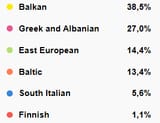>>214578199 (OP)
Vikings attacking northern Spain.
The Viking raids on the coasts of Galicia and Asturias took place mainly between the 9th and 11th centuries.
These expeditions were part of the wider Viking expansion across Europe.
Galicia and Asturias were attractive targets due to their wealthy monasteries and coastal settlements.
The first recorded Viking raid in Iberia occurred in 844, when a fleet reached the Galician coast.
From there, the Vikings attempted to penetrate inland through rivers like the Ulla and the Arousa estuary.
They attacked towns such as Santiago de Compostela, aiming to plunder the famous shrine.
King Ramiro I of Asturias organized defenses and fought the invaders.
According to chronicles, the Asturians defeated the Vikings near the coast of A Coruña.
Many Vikings were killed in battle, and some were executed after capture.
Despite this, Viking fleets returned several times over the following decades.
In 858, a new raid struck Galicia, and the invaders sacked monasteries.
Local rulers fortified towns and encouraged the building of coastal defenses.
The Vikings also raided Asturias, where mountainous terrain limited their inland progress.
Naval battles occurred along the Cantabrian Sea, with varying results.
Some Vikings established temporary camps on islands and estuaries.
Christian chronicles often depicted them as cruel pagans threatening the faithful.
However, archaeology shows limited evidence of permanent Viking settlement in Iberia.
Over time, improved defenses and royal fleets reduced the scale of Viking attacks.
By the late 11th century, Viking activity in Galicia and Asturias had mostly ceased.
These raids left a lasting memory in local legends and medieval chronicles.
 9/6/2025, 2:14:03 PM
No.214578199
>>214578726
>>214578842
>>214579555
>>214581258
>>214581489
>>214582069
9/6/2025, 2:14:03 PM
No.214578199
>>214578726
>>214578842
>>214579555
>>214581258
>>214581489
>>214582069
